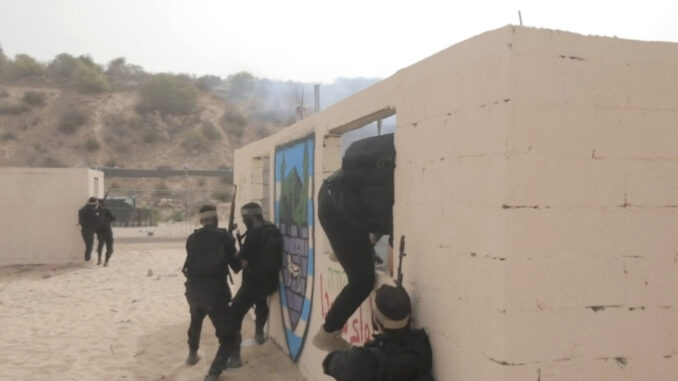
Less than a month before Hamas fighters blew through Israel’s high-tech “Iron Wall” and launched an attack that would leave more than 1,200 Israelis dead, they practiced in a very public dress rehearsal.
A slickly produced two-minute propaganda video posted to social media by Hamas on Sept. 12 shows fighters using explosives to blast through a replica of the border gate, sweep in on pickup trucks and then move building by building through a full-scale reconstruction of an Israeli town, firing automatic weapons at human-silhouetted paper targets.
The Islamic militant group’s live-fire exercise dubbed operation “Strong Pillar” also had militants in body armor and combat fatigues carrying out operations that included the destruction of mock-ups of the wall’s concrete towers and a communications antenna, just as they would do for real in the deadly attack last Saturday.
While Israel’s highly regarded security and intelligence services were clearly caught flatfooted by Hamas’ ability to breach its Gaza defenses, the group appears to have hidden its extensive preparations for the assault in plain sight. One of the compounds Hamas used to prepare was so close to an Israeli border checkpoint that soldiers could have been able to observe the site with binoculars.
“There clearly were warnings and indications that should have been picked up,” said Bradley Bowman, a former U.S. Army officer who is now senior director of the Center on Military and Political Power at the Foundation for Defense of Democracies, a Washington research institute. “Or maybe they were picked up, but they didn’t spark necessary preparations to prevent these horrific terrorist acts from happening.”
Bowman said there are indications that Hamas intentionally led Israeli officials to believe it was preparing to carry out raids in the West Bank, rather than Gaza. It was also potentially significant that the exercise has been held annually since 2020 in December, but was moved up by nearly four months this year to coincide with the anniversary of Israel’s 2005 withdrawal from Gaza.
In a separate video posted to Telegram from last year’s Strong Pillar exercise on Dec. 28, Hamas fighters are shown storming what appears to be a mockup Israeli military base, complete with a full-size model of a tank flying an Israeli flag. The gunmen move through the cinderblock buildings, seizing and cuffing other men playing the roles of Israeli soldier hostages.
Michael Milshtein, a retired Israeli colonel who previously led the military intelligence department overseeing the Palestinian territories, said he was aware of the Hamas videos, but was still caught off guard by the ambition and scale of the attack.
“We knew about the drones, we knew about booby traps, we knew about cyberattacks and the marine forces. The surprise was the coordination between all those systems,” Milshtein said.
The seeds of Israel’s failure to anticipate and stop last Saturday’s attack go back at least a decade. Faced with recurring attacks from Hamas militants tunneling under Israel’s border fence, Prime Minister Benjamin Netanyahu proposed a concrete solution — build a bigger wall.
With financial help from U.S. taxpayers, Israel completed construction of a $1.1 billion project to fortify its existing defenses along its 40-mile land border with Gaza in 2021. The new, upgraded barrier includes a “smart fence” up to 19.7 feet high, festooned with cameras that can see in the dark, razor wire and seismic sensors capable of detecting the digging of tunnels more than 200 feet below. Manned guard posts were replaced with concrete towers topped with remote-controlled machine guns.
“In our neighborhood, we need to protect ourselves from wild beasts,” Netanyahu said in 2016, referring to Palestinians and neighboring Arab states. “At the end of the day as I see it, there will be a fence like this one surrounding Israel in its entirety.”
Shortly after dawn on Saturday, Hamas fighters pushed through Netanyahu’s wall in a matter of minutes. And they did it on the relative cheap, using explosive charges to blow holes in the barrier and then sending in bulldozers to widen the breaches as fighters streamed through on motorcycles and in pick-up trucks. Cameras and communications gear were bombarded by grenades and mortar shells dropped from off-the-shelf, commercial drones — a tactic borrowed directly from the battlefields of Ukraine.
Snipers took out Israel’s sophisticated roboguns by targeting their exposed ammunition boxes, causing them to explode. Militants armed with assault rifles used paragliders to sail over the Israeli defenses, providing Hamas airborne troops despite lacking airplanes. Increasingly sophisticated homemade rockets capable of striking Tel Aviv substituted for a lack of heavy artillery.
Satellite images analyzed by the AP show the massive extent of the damage done at the heavily fortified Erez border crossing between Gaza and Israel. The images taken Sunday showed gaping holes in three sections of the border wall, the largest more than 230 feet wide.
Once the wall was breached, Hamas fighters streamed through by the hundreds. A video showed a lone Israeli battle tank rushing to the sight of the attack, only to be attacked and destroyed in a ball of flame. Hamas then disabled radio towers and radar sites, likely impeding the ability of Israeli commanders to see and understand the extent of the attack.
Hamas forces also struck a nearby army base near Zikim, engaging in an intense firefight with Israeli troops before overrunning the post. Videos posted by Hamas show graphic scenes with dozens of dead Israeli soldiers.
They then fanned out across the countryside of Southern Israel, attacking kibbutzim and a music festival. On the bodies of some of the Hamas militants killed during the invasion were detailed maps showing planned zones and routes of attack, according to images posted by Israeli first responders who recovered some of the corpses. Israeli authorities announced last week they had recovered the bodies of about 1,500 Islamic fighters, though no details were provided about where they were found or how they died.
Military experts told the AP the attack showed a level of sophistication not previously exhibited by Hamas, likely suggesting they had external help.
Ali Barakeh, a Beirut-based senior Hamas official, acknowledged that over the years the group had received supplies, financial support, military expertise and training from its allies abroad, including Iran and Hezbollah. But he insisted the recent operation to breach Israel’s border defenses was homegrown, with the exact date and time for the attack known only to a handful of commanders within Hamas.
Details of the operation were kept so tight, Barakeh said, that some Hamas fighters who took part in the assault believed they were heading to just another drill, showing up in street clothes rather than their uniforms.
Even with all its high-tech gadgets, the Iron Wall was still largely just a physical barrier that could be breached, said Victor Tricaud, a senior analyst with the London-based consulting firm Control Risks.
“The fence, no matter how many sensors … no matter how deep the underground obstacles go, at the end of the day, it’s effectively a metal fence,” he said. “Explosives, bulldozers can eventually get through it. What was remarkable was Hamas’s capability to keep all the preparations under wraps.”



